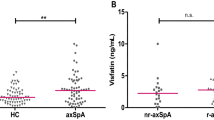Abstract
Our aim in this study was to investigate serum hyaluronic acid (HA) levels and the relationship between clinical parameters in ankylosing spondylitis (AS). Approximately 30 patients with AS and 30 healthy individuals were recruited in this study consecutively. Cross-sectional study was planned, and demographic, clinical, functional, radiological, and laboratory data of patients were evaluated. Disease activity, functional status, and quality of life were assessed, respectively, with Bath Ankylosing Spondylitis Disease Activity Index (BASDAI), Bath Ankylosing Spondylitis Functional Index (BASFI), and Short-Form 36 (SF-36). Mander Enthesis Index (MEI) was used for evaluation of enthesis involvement. We examined serum concentrations of HA (ng/ml) in patients with AS and controls. The mean ages of patients and control group were 38.3 (SD = 10.8) and 42.7 (SD = 10.6) years, respectively. The mean of serum HA levels in AS patients was 40.4 (SD = 34.8) ng/ml and in controls was 24.9 (SD = 20.2). There was significant difference of HA levels between two groups (p = 0.04). Furthermore, there was a significant correlation between HA level and distance of hand–floor (r = 0.444, p = 0.014), modified lumbar Schober’s (r = −0.413, p = 0.023), distance of chin to chest (r = 0.436, p = 0.016), right sacroiliit grade (r = 0.601, p < 0.001), left sacroiliit grade (r = 0.610, p < 0.001), C reactive protein level (r = 0.404, p = 0.027), albumin (r = −0.464, p = 0.010), C3 (p = 0.449, p = 0.013), and IgA levels (r = 0.369, p = 0.045). However, there was no significant correlation between HA levels with MEI, BASFI, BASDAI, and SF-36 (p ≥ 0.05). Serum HA level was significantly higher in AS patients than controls. However, there was no significant correlation between serum HA level and disease-specific measures as BASFI and BASDAI; it had significant relation with spinal mobility limitation, sacroiliitis, and laboratory parameters related with acute inflammation. The serum HA level may be a potential biomarker of axial inflammation and disease severity in AS.
Similar content being viewed by others
References
Khan MA (2002) Ankylosing spondylitis: Introductory comments on its diagnosis and treatment. Ann Rheum Dis 61(Suppl 3):3–7
Khan MA (2002) Update on spondyloarthropathies. Ann Intern Med 136:896–907
Van der Linden S, Van der Heijde D, Braun J (2005) Spondyloarthropathies: Ankylosing Spondylitis. In: Harris ED (ed) Kelley’s textbook of Rheumatology, 7th edn. Elsevier, Philadelphia, pp 1125–1142
Garnero P, Rousseau JC, Delmas PD (2000) Molecular basis and clinical use of biochemical markers of bone, cartilage, and synovium in joint diseases. Arthritis Rheum 43:953–968
Wells AF, Klareskog L, Lindblad S, Laurent TC (1992) Correlation between increased hyaluronan localized in arthritic synovium and the presence of proliferating cells: a role for macrophage-derived factors. Arthritis Rheum 35:391–396
Laurent TC, Dahl IM, Dahl LB, Engstrom-Laurent A, Eriksson S, Fraser JR et al (1986) The catabolic fate of hyaluronic acid. Connect Tissue Res 15:33–41
Hallgren R, Engstrom-Laurent A, Nisbeth U (1987) Circulating hyaluronate: a potential marker of altered metabolism of the connective tissue in uremia. Nephron 46:150–154
Wilkinson CR, Bower LM, Warren C (1996) The relationship between hyaluronidase activity and hyaluronic acid concentration in sera from normal controls and from patients with disseminated neoplasm. Clin Chim Acta 256:165–173
Manley G, Warren C (1987) Serum hyaluronic acid in patients with disseminated neoplasm. J Clin Pathol 40:626–630
Faber J, Horslev-Petersen K, Perrild H, Lorenzen I (1990) Different effects of thyroid disease on serum levels of procollagen III N-peptide and hyaluronic acid. J Clin Endocrinol Metab 71:1016–1021
Ozasa H, Chichibu K, Tanaka Y, Kondo T, Kitajima K, Ota K (1992) Relationship between plasma levels of hyaluronic acid and amyloid-associated osteoarthropathy in chronic hemodialysis patients. Nephron 61:187–191
Engstrom-Laurent A, Hallgren R (1985) Circulating hyaluronate in rheumatoid arthritis: relationship to inflammatory activity and the effect of corticosteroid therapy. Ann Rheum Dis 44:83–88
Lundin A, Engstrom-Laurent A, Hallgren R, Michaelsson G (1985) Circulating hyaluronate in psoriasis. Br J Dermatol 112:663–671
Goldberg LR, Huff JP, Lenz ME, Glickman P, Katz R, Thonar EJMA (1991) Elevated plasma levels of hyaluronate in patients with osteoarthritis and rheumatoid arthritis. Arthritis Rheum 34:799–807
Turan Y, Bal S, Gurgan A (2007) Serum Hyaluronic Acid Levels in Patients with Knee Osteoarthritis. Clinical Rheumatol 26(8):1293–1298
Van der Linden S, Valkenburg HA, Cats A (1984) Evaluation of diagnostic criteria for ankylosing spondylitis: a proposal for the modification of the New York criteria. Arthritis Rheum 27:361–368
Garrett S, Jenkinson T, Kennedy LG, Whitelock H, Gaisford P, Calin A (1994) A new approach to defining disease status in ankylosing spondylitis: the Bath Ankylosing Spondylitis Disease Activity Index. J Rheumatol 21:2286–2291
Calin A, Garrett S, Whitelock H, Kennedy LG, O’Hea J, Mallorie P, Jenkinson T (1994) A new approach to defining functional ability in ankylosing spondylitis: the development of the Bath Ankylosing Spondylitis Functional Index (BASFI). J Rheumatol 21:2281–2285
Akkoc Y, Karatepe AG, Akar S, Kirazli Y, Akkoc N (2005) A Turkish version of the Bath Ankylosing Spondylitis Disease Activity Index: reliability and validity. Rheumatol Int 25(4):280–284
Yanik B, Gursel YK, Kutlay S, Ay S, Elhan AH (2005) Adaptation of the Bath Ankylosing Spondylitis Functional Index to the Turkish population, its reliability and validity: functional assessment in AS. Clin Rheumatol 24(1):41–47
Ware JE Jr (2000) SF-36 Health Survey Update. Spine 25:3130–3139
Mander M, Simpson JM, Mc Lellan A, Walker D, Goodacre JA, Dick WC (1987) Studies with an enthesis index as a method of clinical assessment in ankylosing spondylitis. Ann Rheum Dis 46:197–202
Emlen W, Nıebur J, Flanders G, Rutledge J (1996) Measurement of serum hyaluronic acid in patients with rheumatoid arthritis: Correlation with disease activity. The J Rheumatol 23:974–978
Paimela L, Heiskanen A, Kurki P, Helve T, Repo ML (1991) Serum hyaluronate level as a predictor of radiologic progression in early rheumatoid arthritis. Arthritis and Rheum 34:815–821
Levesque H, Delpech B, Le Loet X, Deshayes P (1988) Serum hyaluronate in rheumatoid arthritis: study by affino-immunoenzymatic. Br J Rheumatol 27(6):445–449
Francois RJ, Gardner DL, Degrave EJ, Bywaters EG (2000) Histopathologic evidence that sacroiliitis in ankylosing spondylitis is not merely enthesitis. Arthritis Rheum 43:2011–2024
Khan MA (2003) Spondyloarthropathies: Clinical features of ankylosing spondylitis. Rheumatology, 4th edn. In: Hochberc MC, Silman AJ, Smolen JS, Weinblatt ME, Weishman MH (eds) Toronto, pp. 1161–1181
Nishida Y, D’Souza AL, Thonar EJM, Knudson W (2000) Stimulation of hyaluronan metabolism by interleukin 1α in human articular cartilage. Arthritis Rheum 43:1315–1326
Sharif M, George E, Shepstone L, Knudson W, Thonar EJ, Cushnaghan J, Dieppe P (1995) Serum Hyaluronic Acid level as a predictor of disease progression in osteoarthritis of the knee. Arthritis Rheum 38:760–767
Horslev-Petersen K, Bentsen KD, Engström-Laurent A, Junker P, Halberg P, Lorenzen I (1988) Serum amino terminal type III procollagen peptide and serum hyaluronan in rheumatoid arthritis: relation to clinical and serological parameters of inflammation during 8 and 24 months treatment with levamisole, penicilamine, or azothioprine. Ann Rheum Dis 47:116–126
Elkayam O, Yaron I, Shirazi I, Yaron M, Caspi D (2000) Serum levels of hyaluronic acid in patients with psoriatic arthritis. Clin Rheumatol 19:455–457
Author information
Authors and Affiliations
Corresponding author
Additional information
This manuscript was accepted as an abstract presentation at the Annual European Congress of Rheumatology (EULAR), 8–11 June 2005, Vienna, Austria.
Rights and permissions
About this article
Cite this article
Duruöz, M.T., Turan, Y., Cerrahoglu, L. et al. Serum hyaluronic acid levels in patients with ankylosing spondylitis. Clin Rheumatol 27, 621–626 (2008). https://doi.org/10.1007/s10067-007-0757-0
Received:
Revised:
Accepted:
Published:
Issue Date:
DOI: https://doi.org/10.1007/s10067-007-0757-0




